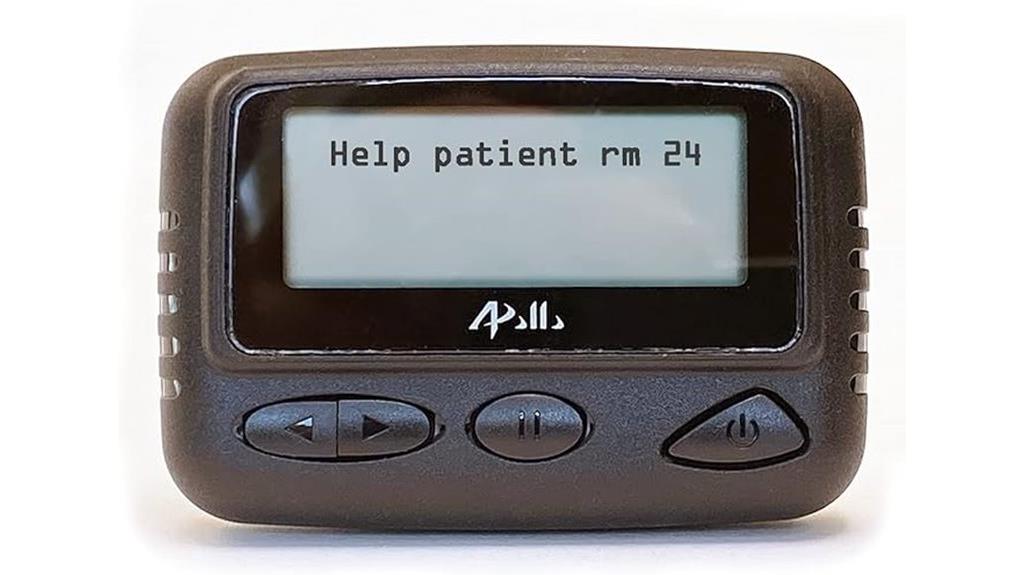When I first came across the Apollo Programmable Alpha Pager, I was intrigued by its compact design and practical features. It seems like a fitting choice for environments such as nursing homes or assisted living facilities. However, I couldn’t help but wonder about its limitations, particularly with compatibility and alert modes. Let’s explore what makes this pager stand out—and what might hold it back in certain situations.
Overview of the Apollo Programmable Alpha Pager
When you’re looking for a reliable paging solution, the Apollo Programmable Alpha Pager stands out with its compact design and impressive features.
This pager is specifically crafted for in-building use, making it ideal for environments like nursing homes. It replaces older models, offering an upgraded experience without the hassle of compatibility issues with long-range networks.
Weighing just 1.75 ounces and fitting easily in your hand, it’s portable enough to carry everywhere. I appreciate that it’s designed with user convenience in mind, ensuring you can stay connected without the bulk.
It’s a solid choice for anyone needing dependable communication on-site.
Key Features and Specifications
The Apollo Programmable Alpha Pager boasts impressive features that enhance its functionality and user experience.
It’s a compact, beeper-style pager with a convenient belt clip. The four-line display shows true alpha characters, allowing easy reading.
With a large memory capacity, it holds up to 28,672 characters and 10 full messages across 16 slots. You’ll appreciate the variety of alerts, including four beep tones and ten melodies, plus a vibration sleep mode.
Powered by a single AAA battery, it lasts 3-4 months. Measuring just 2.9 x 2 x 0.75 inches and weighing 1.75 ounces, it’s lightweight and portable.
Usage Scenarios and Compatibility
In many healthcare settings, the Apollo Programmable Alpha Pager proves invaluable for efficient communication. I’ve seen it thrive in nurse-call systems, especially in assisted living facilities where quick alerts are essential. However, it’s essential to note that this pager isn’t designed for Wide Area Paging. Here’s a quick look at its usage scenarios and compatibility:
| Scenario | Compatibility | Notes |
|---|---|---|
| Nurse-call systems | 450-470MHz frequency | Ideal for in-building use |
| Assisted living | Not for 900 MHz | Great replacement option |
| Group paging | Programmable settings | Flexible communication |
This pager delivers efficiency where it counts!
Customer Feedback and Common Issues
While the Apollo Programmable Alpha Pager excels in various healthcare settings, feedback from users reveals a mix of experiences.
Some folks have reported compatibility issues with specific frequencies, like DAPNET, which can be frustrating.
I’ve also noticed concerns about missing accessories, such as a screen protector, upon purchase.
Others express disappointment over the lack of a vibrate mode and issues like screen flickering.
Overall, while it has its strengths, I can see why some users feel the performance and features don’t quite measure up to older models.
It’s crucial to weigh these factors when considering this pager.
Final Thoughts on the Apollo Pager
Considering the mixed reviews, I find the Apollo Programmable Alpha Pager to be a solid option for those in healthcare environments, but it may not be the best fit for everyone.
Its compact size, impressive memory capacity, and customizable alerts cater well to busy professionals. However, users should be cautious of compatibility issues and the occasional missing accessories.
While it performs adequately in nurse-call systems, some might be disappointed by features that were better in older models.
Ultimately, if you seek a reliable pager for specific settings, the Apollo could serve you well, but weigh your options carefully.

